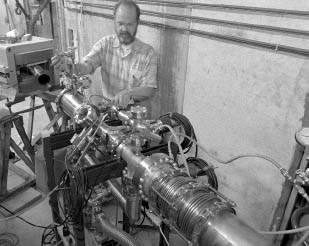 |
|
Future Cool by Mike Perricone Electron cooling project hopes to boost effectiveness of Recycler and Tevatron 
Research and development can be defined as dreaming up ways to improve something that doesn’t yet exist. Consider the case of electron cooling. In 1995, when the Main Injector was a construction project and the Antiproton Recycler was an idea, Fermilab had already begun to investigate electron cooling as a means of extending the Recycler’s ability to hoard antiprotons—even further enhancing the Tevatron’s luminosity, the production of proton-antiproton collisions, in Run II and beyond. "The thinking at the Lab seems to be that we’ll go beyond Run II, not by declaring an end point and the beginning of a new run, but by continually progressing and improving the capability of the machines,” said Jim MacLachlan, a full-time member of the electron cooling group. Led by Sergei Nagaitsev, the group has placed an order for a $2.5 million device called the Pelletron, which will provide the source of electrons for cooling the antiproton beam in the Recycler—with the hope of eventually escalating the Tevatron luminosity by another factor of four beyond the anticipations from the Main Injector and Recycler. The Pelletron is old-fashioned accelerator technology: an electrostatic generator of the Van de Graaff type, using a conveyor to carry charge and create voltage. The Pelletron is manufactured in Middleton, Wisconsin by National Electrostatics Corporation. Its name derives from the charging chain of metal pellets that replaces the conventional conveyor belts. The unit for Fermilab will generate five million electron volts (5 MeV), in a tower assembly 7.3 meters high and 3.7 meters in diameter (about 24 feet by 12 feet). It will be delivered in stages beginning next March, and Nagaitsev hopes to begin commissioning in July 2000. Nagaitsev and other group full-timers, including Alexander Shemyakin, Alexei Burov and Arden Warner, have also spent much time at NEC, using the company’s testing facilities to push the Pelletron’s beam current beyond its intrinsic capabilities. They’ve developed a high efficiency of returning the charge to the high voltage terminal, so that current only needs to be added to make up for beam loss. "We’re using old technology and doing new things with it, things that no one has done before,” Nagaitsev said. Electrons are used for cooling the antiproton beam because they’re easier to produce than any other charged particles. The concept was developed in 1964 in Novosibirsk, Russia (where Shemyakin, Burov and Nagaitsev have studied), and was tested at Fermilab and at CERN in the 1970s. But the alternative stochastic cooling method came to prominence after it was developed at CERN. Much of Fermilab’s original electron cooling test apparatus was sent to Indiana University—where Nagaitsev later earned his PhD. Electron cooling was also proposed for the medium energy booster of the Superconducting Super Collider. Congress pulled the plug on the SSC in 1993, but the electron cooling idea created a spark when MacLachlan met Nagaitsev at a conference at Indiana in 1994. A possible match between electron cooling and the Antiproton Recycler was too good to pass up. Electron cooling is envisioned as a further cooling step for the Recycler after stochastic cooling reaches its peak. Stochastic cooling is a sort of remote control process, signaling individual particles in the beam to fall into line. Electron cooling works by a series of collisions, transferring heat or energy from one particle to another. Think of a cue ball scattering a series of billiard balls. In each collision, the cue ball transfers some of its energy to another ball. The antiproton is the cue ball, losing its energy; the electrons are the other billiard balls, absorbing bits of energy with each collision. Eventually, the balls (particles) will reach an energy equilibrium. The cooling will take place in a 20-meter-long stretch of the Recycler beam pipe, with both the antiproton and electron beam flowing at identical velocities. The electron beam will surround the antiproton beam as completely as possible. The antiproton beam is densest in the center, but has thin tails extending from it. The art in setting the size of the roughly concentric outer electron beam is in deciding how much of the antiproton beam is expendable, since enlarging the electron beam decreases its density and its cooling effectiveness. Nagitsev’s group hopes to cool 95 percent of the antiproton beam. Making these light-speed beams coexist requires extreme precision. Warner is working on the diagnostics, the instruments for measuring the beams’ positions and characteristics. The alignment tolerance is an angle of about 50 microradians; to produce the same angle, a triangle would need an apex six feet away from a base as wide as the diameter of a human hair. Another challenge lies in continually introducing the electron beam into the beam pipe, wrapping it around the antiproton beam, and then extracting it to be collected, cooled and replenished—with minimum, if any, disturbance to the antiproton beam. Here, Nagaitsev explained, the mass difference between the particles offers a critical advantage. At 1/2,000 of the mass of the antiprotons, the electron beam can be bent 90 degrees with 1/2,000 of the magnetic field it would take to produce a 90-degree bend in the antiproton beam. The antiproton beam also passes through only a small segment of the bending magnet and barely feels the effects of the weak magnetic field used to inject and extract the electron beam. Any residual disturbances can be easily corrected in the antiproton beam. Nagaitsev cautions that no research and development project is sure of success, but MacLachlan likes what he’s seen. "Our experience has been that more we understand it, the better it looks,” he said. "That’s a very qualitative statement. But it’s a rare thing to say in the early stages of a project.” |
| last modified 8/20/1999 email Fermilab |
FRLsDFx9eyfrPXgV